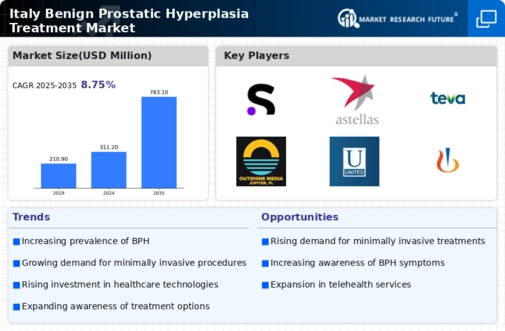The benign prostatic hyperplasia treatment market in Italy is characterized by a competitive landscape that is increasingly shaped by innovation and strategic partnerships. Key players such as Astellas Pharma (Japan), Boehringer Ingelheim (Germany), and Eli Lilly and Company (US) are actively pursuing strategies that emphasize research and development, regional expansion, and digital transformation. Astellas Pharma, for instance, has focused on enhancing its product portfolio through innovative therapies, which positions it favorably against competitors. Meanwhile, Boehringer Ingelheim has been investing in partnerships aimed at improving patient access to treatments, thereby strengthening its market presence. Collectively, these strategies contribute to a dynamic competitive environment where companies are not only vying for market share but also striving to meet evolving patient needs.
In terms of business tactics, companies are increasingly localizing manufacturing and optimizing supply chains to enhance efficiency and reduce costs. The market structure appears moderately fragmented, with several players holding significant shares, yet the influence of major companies remains pronounced. This competitive structure allows for a variety of treatment options for patients, while also fostering an environment where innovation is crucial for maintaining market position.
In October 2025, Astellas Pharma (Japan) announced a collaboration with a leading Italian healthcare provider to enhance the delivery of its BPH treatments. This strategic move is likely to improve patient access and streamline distribution channels, thereby reinforcing Astellas's commitment to patient-centric care. Such collaborations may also serve to bolster the company's reputation within the Italian market, potentially leading to increased sales and market penetration.
In September 2025, Boehringer Ingelheim (Germany) launched a new digital platform aimed at educating healthcare professionals about the latest advancements in BPH treatment. This initiative not only underscores the company's focus on digital transformation but also positions it as a thought leader in the field. By investing in educational resources, Boehringer Ingelheim may enhance its relationships with healthcare providers, ultimately driving adoption of its therapies.
In August 2025, Eli Lilly and Company (US) expanded its clinical trial program for a novel BPH treatment in Italy, reflecting its commitment to innovation and research. This expansion is significant as it may lead to the introduction of new therapies that address unmet medical needs, thereby enhancing the company's competitive edge. The focus on clinical trials also indicates a long-term strategy aimed at establishing a robust pipeline of products that can cater to diverse patient populations.
As of November 2025, current trends in the benign prostatic hyperplasia treatment market are increasingly defined by digitalization, sustainability, and the integration of artificial intelligence. Strategic alliances are becoming more prevalent, as companies recognize the value of collaboration in navigating complex market dynamics. Looking ahead, competitive differentiation is likely to evolve, with a shift from price-based competition to a focus on innovation, technology, and supply chain reliability. This transition may ultimately lead to improved patient outcomes and a more sustainable market environment.






















Leave a Comment